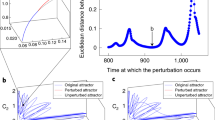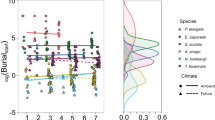Abstract
Aggregate community-level response to disturbance is a principle concern in ecology because post-disturbance dynamics are integral to the ability of ecosystems to maintain function in an uncertain world. Community-level responses to disturbance can be arrayed along a spectrum ranging from synchronous oscillations where all species rise and fall together, to compensatory dynamics where total biomass remains relatively constant despite fluctuations in the densities of individual species1. An important recent insight is that patterns of synchrony and compensation can vary with the timescale of analysis2 and that spectral time series methods can enable detection of coherent dynamics that would otherwise be obscured by opposing patterns occurring at different scales3. Here I show that application of wavelet analysis to experimentally manipulated plankton communities reveals strong synchrony after disturbance. The result is paradoxical because it is well established that these communities contain both disturbance-sensitive and disturbance-tolerant species leading to compensation within functional groups4,5. Theory predicts that compensatory substitution of functionally equivalent species should stabilize ecological communities6,7,8,9,10, yet I found at the whole-community level a large increase in seasonal biomass variation. Resolution of the paradox hinges on patterns of seasonality among species. The compensatory shift in community composition after disturbance resulted in a loss of cold-season dominants, which before disturbance had served to stabilize biomass throughout the year. Species dominating the disturbed community peaked coherently during the warm season, explaining the observed synchrony and increase in seasonal biomass variation. These results suggest that theory relating compensatory dynamics to ecological stability needs to consider not only complementarity in species responses to environmental change, but also seasonal complementarity among disturbance-tolerant and disturbance-sensitive species.
This is a preview of subscription content, access via your institution
Access options
Subscribe to this journal
Receive 51 print issues and online access
$199.00 per year
only $3.90 per issue
Buy this article
- Purchase on Springer Link
- Instant access to full article PDF
Prices may be subject to local taxes which are calculated during checkout



Similar content being viewed by others
References
Micheli, F. et al. The dual nature of community variability. Oikos 85, 161–169 (1999)
Keitt, T. H. & Fischer, J. Detection of scale-specific community dynamics using wavelets. Ecology 87, 2895–2904 (2006)
Vasseur, D. A. & Gaedke, U. Spectral analysis unmasks synchronous and compensatory dynamics in plankton communities. Ecology 88, 2058–2071 (2007)
Fischer, J. M., Frost, T. M. & Ives, A. R. Compensatory dynamics in zooplankton community responses to acidification: Measurement and mechanisms. Ecol. Appl. 11, 1060–1072 (2001)
Frost, T. M., Fischer, J. M., Klug, J. L., Arnott, S. E. & Montz, P. K. Trajectories of zooplankton recovery in the Little Rock Lake whole-lake acidification experiment. Ecol. Appl. 16, 353–367 (2006)
Tilman, D. The ecological consequences of changes in biodiversity: a search for general principles. Ecology 80, 1455–1474 (1999)
McCann, K. S. The diversity-stability debate. Nature 405, 228–233 (2000)
Cottingham, K. L., Brown, B. L. & Lennon, J. T. Biodiversity may regulate the temporal variability of ecological system. Ecol. Lett. 4, 72–85 (2001)
Loreau, M. et al. Ecology - Biodiversity and ecosystem functioning: Current knowledge and future challenges. Science 294, 804–808 (2001)
Hooper, D. U. et al. Effects of biodiversity on ecosystem functioning: A consensus of current knowledge. Ecol. Monogr. 75, 3–35 (2005)
Forst, T. M. et al. The experimental acidification of Little Rock Lake. In Long-Term Dynamics of Lakes in the Landscape (eds Magnuson, J. J., Kratz, T. K. & Benson, B. J.) (Oxford Univ. Press, New York, 2005)
Maraun, D. & Kurths, J. Cross wavelet analysis: significance testing and pitfalls. Nonlin. Processes Geophys. 11, 505–514 (2004)
Daubechies, I. Ten Lectures On Wavelets. CBMS-NSF Regional Conference Series in Applied Mathematics (Society for Industrial and Applied Mathematics, Philadelphia, 1992)
Rao, J. S. & SenGupta, A. Topics in Circular Statistics (World Scientific, Singapore, 2001)
Houlahan, J. E. et al. Compensatory dynamics are rare in natural ecological communities. Proc. Natl Acad. Sci. USA 104, 3273–3237 (2007)
Moran, P. A. P. The statistical analysis of the Canadian lynx cycle. II. synchronization and meteorology. Aust. J. Zool. 1, 291–298 (1953)
Kent, A. D., Yannarell, A. C., Rusak, J. A., Triplett, E. W. & McMahon, K. D. Synchrony in aquatic microbial community dynamics. ISME J. 1, 38–47 (2007)
Carpenter, S. R., Kitchell, J. F. & Hodgson, J. R. Cascading trophic interactions and lake productivity. Bioscience 35, 634–639 (1985)
Ives, A. R. Predicting the response of populations to environmental change. Ecology 76, 926–941 (1995)
Pace, M. L., Cole, J. J., Carpenter, S. R. & Kitchell, J. F. Trophic cascades revealed in diverse ecosystems. Trends Ecol. Evol. 14, 483–488 (1999)
Vasseur, D. A. & Fox, J. W. Environmental fluctuations can stabilize food web dynamics by increasing synchrony. Ecol. Lett. 10, 1066–1074 (2007)
Downing, A. L., Brown, B. L., Perrin, E. M., Keitt, T. H. & Leibold, M. A. Environmental fluctuations induce scale-dependent compensation and increase stability in plankton ecosystems. Ecology (in the press)
Mallat, S. A Wavelet Tour of Signal Processing 2nd edn (Academic, New York, 1999)
Grenfell, B. T., Bjornstad, O. N. & Kappey, J. Travelling waves and spatial hierarchies in measles epidemics. Nature 414, 716–723 (2001)
Percival, D. B. & Walden, A. T. Wavelet Methods in Time Series Analysis. Cambridge Series in Statistical and Probabilistic Mathematics (Cambridge Univ. Press, Cambridge, UK, 2002)
Grossmann, A. & Morlet, J. Decomposition of Hardy functions into square integrable wavelets of constant shape. SIAM J. Math. Anal. 15, 723–736 (1984)
Ernest, S. K. M. & Brown, J. H. Homeostasis and compensation: the role of species and resources in ecosystem stability. Ecology 82, 2118–2132 (2001)
Solow, A. & Duplisea, D. Testing for compensation in a multi-species community. Ecosystems 10, 1034–1038 (2007)
Benjamini, Y. & Yekutieli, D. The control of the false discovery rate in multiple testing under dependency. Ann. Statist. 29, 1165–1188 (2001)
Acknowledgements
I thank J. Fischer and M. Kirkpatrick for their comments on the manuscript.
Author information
Authors and Affiliations
Corresponding author
Supplementary information
Supplementary information
The file contains Supplementary Figures S1-S3 with Legends. Figure S1 provides additional supporting evidence for the conclusion of synchronous dynamics under disturbance. Figures S2 and S3 apply the wavelet modulus ratio and phase perturbation methods to simulated data. (PDF 514 kb)
Rights and permissions
About this article
Cite this article
Keitt, T. Coherent ecological dynamics induced by large-scale disturbance. Nature 454, 331–334 (2008). https://doi.org/10.1038/nature06935
Received:
Accepted:
Published:
Issue Date:
DOI: https://doi.org/10.1038/nature06935
This article is cited by
-
Variation in the fatty acid profiles of two cold water diatoms grown under different temperature, light, and nutrient regimes
Journal of Applied Phycology (2021)
-
Common Species Stability and Species Asynchrony Rather than Richness Determine Ecosystem Stability Under Nitrogen Enrichment
Ecosystems (2021)
-
Long-term cyclic persistence in an experimental predator–prey system
Nature (2020)
-
Application of spectral analysis and wavelet transforms to full-scale dynamic drainages at minesites
SN Applied Sciences (2019)
-
SARI: interactive GNSS position time series analysis software
GPS Solutions (2019)
Comments
By submitting a comment you agree to abide by our Terms and Community Guidelines. If you find something abusive or that does not comply with our terms or guidelines please flag it as inappropriate.



